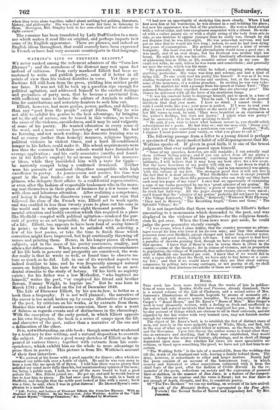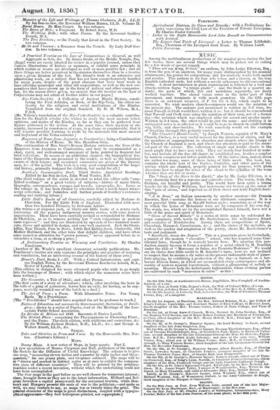PUBLICATIONS RECEIVED.
Boone.
Tnis week luts been more fruitful than the weeks of late in %Italica- lions of some mark. Besides Stella and Vanessa, already dismissed, there is a second volume of the Life of Chalmers' and a second series of Mrs. Jameson's Illustrations of Monastic Legends by means of monastic art; both of which will deserve notice hereafter. We are less certain of Miss Cooper's "Rural Hours," and Dr. Knox's "Races of Men" Miss Cooper's work is very pleasantly written with a feeling as fresh and unaffected as the nature and natural incidents have employed her pen, but the day- by-day account of things which are obvious to all in their externals, and not regarded by the fair writer with very learned eyes, may not furnish matter enough for extended notice.
The object of Dr. Knox's book is to establish the fact of distinct races of men, not merely in the more palpable types of White, Black, and Red, but in the case of what are now called tribes or nations, as the Saxon, the Celt, and the Slovenian. Upon this theory the author seems to found other theo- ries so extensive and startling, that if they were established, they would make a change in the sciences of history, physiology, and in short all things dependent upon man. But whether his views are mere speculative as- sertions, or based upon something like proof, we have not yet had time to as- certain.
"The Wedding Belle" is the tale of a married life, from the wedding-day till the death of the husband and wife, leaving a family behind them. The dory, however, is subordinate to other and larger matters. Nearly half the poem consists of an account of the honeymoon tour ; in which scenery and historical or other associations connected with it form the chief topic of the poet, after the fashion of Childe Harold. In the re- mainder of the poem, reflections on society and the expression of personal likes or dislikes, in the manner of Dom Juan, is a feature of the composi- tion. The ideas are copious and the verse is fluent; but we fear there is not enough of depth, thought, and fire, to constitute poetry.
Of "The Two Brothers" we can say nothing, on account of its late arrival. le rads of the Monastic Orders, as represented in the Fine Arts. Forniin; the Second Series of Sacred and Legendary Art. By Mrs. Jamems.
Memoirs of the Life and Writings of Thomas Chalmers, D.D., LL.D. By his Son-in-law, the Reverend 'William Hanna, LL.D. Volume II. .Bural Hours. By Miss Cooper. In two volumes. The Races of lien; a Fragment. By Robert Knox, M.D. The Wedding Bells; with other Poems. By the Reverend Godfrey Everth, M.A. The Two Brothers; or the Family that Lived in the First Society. In two volumes.
* St.:24 and Vanessa ; a Romance from the French. By Lady Duff Gor- don. In two volumes.
A Practical Treatise on the Law of Corporations in General, as well
Aggregate as Sole, &c. By James Grant, of the Middle Temple, Esq. [Legal works are rarely adapted for review in a popular journal, unless they contain illustrations of history or manners, or exhibit some principle in which morals or reason are developed as well as mere positive law ; and all these things are better perceived in the statutes themselves than in a treatise upon a given division of the law. Mr. Grant's book is an extensive and painstaking work, on a subject that has not been comprehensively handled for many years, despite of the great changes that have been made in laws affecting municipal and other old corporations, as well as the new cor- porations that have grown up in the form of railway and other companies : but, for the reason above given, we suspect that the treatise on the Law of Corporations may not admit of further notice in our pages.] Big- Veda-S'an h ltd. A Collection of Ancient Hindu Hymns, consti- tuting the First Ashtaka, or Book, of the Rig-Veda, the oldest au- thority for the religious and social institutions of the Hindus. Translated from the original Sanskrit. By II. II. Wilson, M.A.,
[Mr. Wilson's translation of the Rig-Teda-Sanhitd is a valuable contribu- tion for the English scholar who wishes to study the most ancient belief, opinions, and modes of the Hindus, so far as they can be gathered from hymns addressed to the deities. At the same time, their mystery or ob- scanty, increased by remoteness of years, is perhaps so considerable, that it will require peculiar learning to profit by the materials this most ancient runt important of the Vedas contains.]
Emperors of Rome from Augustus to Constantine; being &Continuation of the History of Rome. By Mrs. Hamilton Gray.
[The continuation of Mrs. Gray's Roman History embraces the lives of the },.'perors from Augustus to Constantine, and may be recommended as a clear, rapid, and well-arranged summary of facts, pointed by frequent but brief reflections. By means of an additional chapter, the biographical fea- tures of the Emperors are presented to the reader, as well as the historical events of their reigns; and occasional summaries are given of the literary men, &e. of the period. The book is a very good cmnpendium of the Impe- rialhistory, primarily designed for children, but useful for all.] - Southey's Commonplace Book. Third Series. Analytical Readings. Edited by his Son-m-law, John Wood Wader, B.D. rile third volume of the series is devoted to what the editor calls "ana- lytical readings" on a great variety of subjects,—history of many kinds, biography, correspondence, voyages and travels, topography, &c. Large as
the volume is, it has been formed by selections from a much larger manu- script collection and furnishes still further proofs of Southey's extensive reading and untiring labour.] Little Folk's Books of all Countries'' carefully edited by Madame de Chatelain. For the Little Folk of England. Illustrated with more than two hundred Pictures, by first-rate Artists.
[Six volumes at sixpence each, or thirty-six little books at a penny each, containing all the popular indigenous nursery stories, with some modern importations. These have been carefully revised or retranslated by Madame de Glatelain, Bo as to remove nothing but "such vulgarisms as modern taste reproves": and they are illustrated by upwards of two hundred wood- cuts, clever and spirited in design, and very well engraved. Jack the Giant- killer, Tom Thumb, Puss in Boots, Little Red Riding-hood, Cinderella, Old Mother Hubbard, and the other tales that delight children, and have often some nameless attraction for "grown persons," never appeared before in so attractive a form, at so cheap a price.]
A Rudimentary Treatise on Warming and rentilation. By Charles Tomlinson.
[Another of Mr. Weale's excellent elementary scientific publications. Mr. Tomlinson's treatise not only contains theprinciples and practice of warming and ventilation, but an interesting resume of the history of those arts.]
Homer's Iliad, Books With a Critical Introduction, and copi- ous English Notes, by the Reverend Thomas Kerchever Arnold, ILA., Rector of Lyndon, &e.
[This edition is designed for more advanced pupils who wish to go deeply into the language of Homer ; with which object the numerous notes have been written.] The Gamester, a Tale of 1845; and other Poems. [The first canto of a story of adventure; which, after involving the hero in the toils of a gabg of gamesters, leaves him an exile, for having, as he sup- poses, mortally wounded one of the batch in a duel.] The Art of Verse; a Poem. With Illustrative Notes. For Young Bards. By a Practitioner. [The " Practitiouer " should have acquired the art he professes to teach.] National Education not necessarily Governmental, Sectarian, or Irreli- _ gicts3 shown in a series of Papers, read at the Meetings of the Lan- cashir'e Public School Association.
La Bivolta di _Milano nel 1848. Raeconto di Enrico Lavelli. The British Flora : comprising the Phmnogamous or Flowering Plant, and the Ferns. The sixth edition, with additiona and corrections, &c. By Sir William Jackson Hooker, K.11., LL.D., &c.; and George A. Walker Arnett, LLD., &c.
SERIAL.
Tales and Sketches in Prose and rerse. By the Honourable Mrs. Nor- ton. (Churton's Library.)
MAPS.
Penny Maps. A new series of Maps, in large quarto. Part L [A new speculation of Messrs. Chapman and Hall, publishers of the maps of the Society for the Diffusion of Useful Knowledge. The scheme is to give one map, "measuringeleven inches and aquarter by eight inches and i three-
qin!rters," for one penny h
y plain, and twopence coloured. e maps will be
so "drawn and marked n distinct scales as at once to exhibit the compara- tive sizes of different countries." They will be printed by the printing- machine under a recent invention, without which the undertaking could not have been accomplished. The four maps in the part before us are well chosen for temporary interest; since, brought down as they are to the latest information, Holland and Bel- gium furnishes a capital pennyworth for the autumnal tourists, while Den- mark and Hungary present the seats of war to the politician,—and quite as well, we may venture to say, as maps ten or twenty times the price. The gemeral character of the maps is great distinctness, coupled with a typogra- phieal appearance—they look letterpress-printed, not copperplate.]
PAMPHLETS.
Agricultural Distress, its Cause and Remedy; with a Preliminary In-' quirv concerning the Civil Law of the Freedom of Private Enterpriae. By Charles Foster Cotterill.
_Letter to the Bight Hotiourabk Lord John Russell on Communication with Ireland.
The Export Coal Trade of Liverpool: a Letter to Thomas Littledale, Esq., Chairman of the Liverpool Dock Trust. By William Laird. Public Nurseries.



























 Previous page
Previous page